Ajoba Hill Fort: Best Trekking, History, and Mythological Significance
- Location: Thane
- Entry Fee: Free
- Timings: Open all year round; best to trek between sunrise and sunset.
- Categories: Forts, Historical Place, Tourist Places
- Tags: Ajoba Hill Fort, Ajoba Hill Fort history, Ajoba Hill Fort mythology, Ajoba Hill Fort trek, Best treks near Malshej Ghat, Ramayana Legends, Sahyadri trekking, Sahyadri trekking places
- Location Taxonomy: India, Maharashtra, Thane
Maharashtra’s Sahyadri ranges are dotted with forts and hills that carry centuries of history, mythology, and adventure. Among them, Ajoba Hill Fort (also called Ajobagad or Ajoba Parvat) is one of the most fascinating destinations. Located near Malshej Ghat and Dehene village in the Palghar district, Ajoba Hill Fort is not only a trekking paradise but also a site deeply rooted in the legends of the Ramayana.
You can visit : Mumbai to Malshej Ghat One Day Trip
The word Ajoba means “grandfather” in Marathi, and the hill is believed to be associated with Maharishi Valmiki, the sage who composed the Ramayana. According to mythology, Valmiki sheltered Sita during her exile and raised her sons, Luv and Kush, on this very hill. Today, Ajoba Hill Fort is a blend of spirituality, history, and natural beauty, attracting trekkers, pilgrims, and nature lovers alike.
This article explores the history, trekking routes, attractions, nearby places, and FAQs about Ajoba Hill Fort, making it a complete guide for travelers.
Historical and Mythological Background
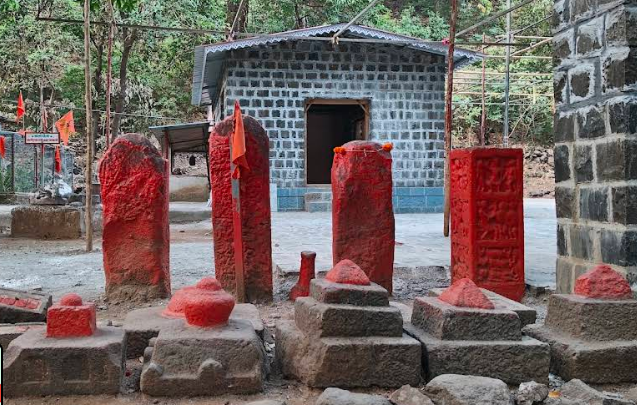
- Ramayana Connection: Ajoba Hill Fort is believed to be the place where Maharishi Valmiki lived. It is said that Sita stayed here after being abandoned by Lord Rama, and her sons Luv and Kush grew up under Valmiki’s guidance.
- Sita Cha Palna (Cradle of Sita): A natural rock formation resembling a cradle is associated with the childhood of Luv and Kush.
- Valmiki Ashram: A sacred site on the hill where Valmiki is believed to have meditated.
- Strategic Importance: Though called a “fort,” Ajoba Hill Fort does not have typical fortifications. Instead, it served as a natural stronghold and spiritual retreat.
Architectural and Natural Features
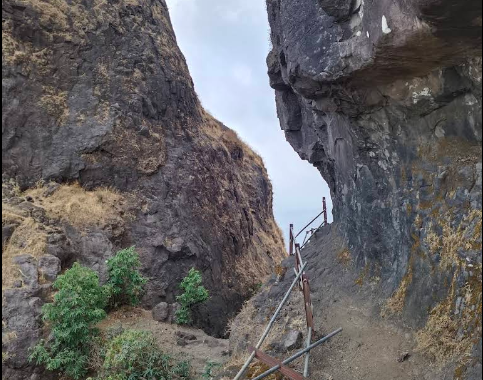
Unlike other forts in Maharashtra, Ajoba Hill Fort is more of a mythological and natural site than a military structure.
Key Highlights:
- Caves: Rock‑cut caves used by sages and trekkers.
- Valmiki Ashram: A small shrine and meditation spot.
- Sita Cha Palna: A cradle‑shaped rock formation.
- Plateau and Meadows: Vast open spaces with wildflowers during monsoon.
- Panoramic Views: Stunning vistas of Malshej Ghat, Harishchandragad, and surrounding valleys.
Trekking Experience at Ajoba Hill Fort
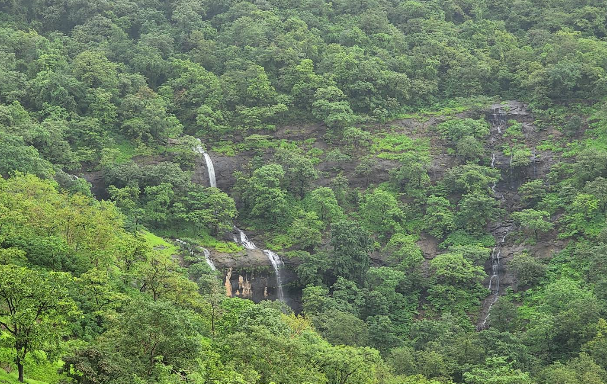
Trekking to Ajoba Hill Fort is one of the most rewarding experiences in the Sahyadris.
Trekking Route:
- Base Village: Dehene, near Shahapur.
- Altitude: 4,511 feet (1,375 meters).
- Duration: 3–4 hours to ascend, 2–3 hours to descend.
- Difficulty Level: Moderate, with forest trails and rocky patches.
- Best Season: Monsoon (July–September) for greenery, and winter (October–February) for clear skies.
Highlights of the Trek:
- Forest Trail: Dense forests with streams and waterfalls.
- Valmiki Ashram: A spiritual stop midway.
- Sita Cha Palna: Mythological landmark.
- Summit Views: Panoramic views of Sahyadris and Malshej Ghat.
- Flora and Fauna: Wildflowers, medicinal herbs, and bird species.
Flora and Fauna
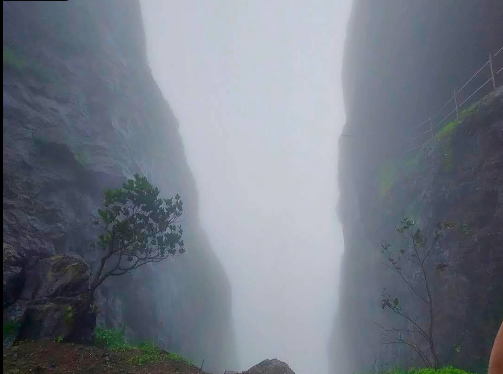
- Flora: Wildflowers like Sonki, Karvi, and medicinal plants.
- Fauna: Monkeys, peacocks, and a variety of birds.
- Birdwatching: Paradise for bird lovers, especially during monsoon.
Location and Accessibility
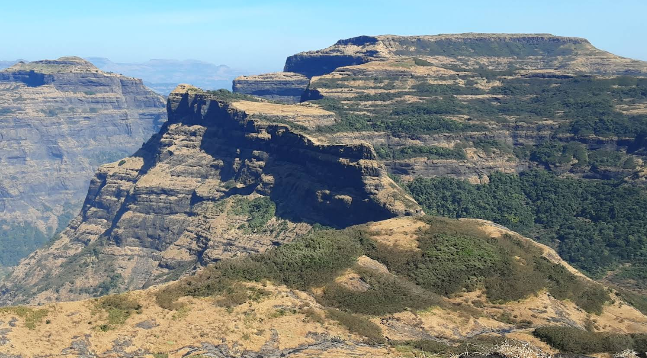
- District: Thane, Maharashtra
- Altitude: 4,511 feet (1,375 meters)
- Nearest Towns: Shahapur (30 km), Malshej Ghat (40 km)
- Nearest Railway Station: Asangaon (45 km)
- Nearest Airport: Mumbai Airport (120 km), Nashik Airport (90 km)
How to Reach:
- From Mumbai: 120 km (approx. 3–4 hours by road).
- From Pune: 180 km (approx. 5–6 hours by road).
- From Nashik: 90 km (approx. 2–3 hours by road).
Best Time to Visit Ajoba Hill Fort
- Monsoon (July–September): Waterfalls, greenery, and misty views.
- Winter (October–February): Pleasant weather, ideal for trekking.
- Summer (March–June): Hot and dry, less recommended.
Entry Fees and Timings
- Entry Fee: Free (no charges for trekking).
- Timings: Open all year round; best to trek between sunrise and sunset.
- Guides: Local guides available at Dehene village.
Things to See at Ajoba Hill Fort
- Valmiki Ashram – Sacred meditation site.
- Sita Cha Palna – Cradle‑shaped rock formation.
- Rock‑Cut Caves – Ancient caves used by sages.
- Plateau and Meadows – Scenic landscapes.
- Panoramic Views – Sahyadri ranges and Malshej Ghat.
- Waterfalls – Seasonal streams during monsoon.
Nearest Tourist Places
- Malshej Ghat (40 km): Famous for waterfalls and monsoon beauty.
- Harishchandragad Fort (30 km): Known for Konkan Kada and ancient temples.
- Shivneri Fort (50 km): Birthplace of Chhatrapati Shivaji Maharaj.
- Naneghat (35 km): Ancient trade route with caves and inscriptions.
- Trimbakeshwar (80 km): One of the 12 Jyotirlingas of Lord Shiva.
Travel Tips for Visitors
- Wear trekking shoes with good grip.
- Carry water, snacks, and a raincoat during monsoon.
- Start early to avoid crowds and enjoy sunrise views.
- Hire a local guide for insights into history and mythology.
- Respect local traditions and avoid littering.
❓ FAQs about Ajoba Hill Fort
Q1: Why is Ajoba Hill Fort famous?
A: It is famous for its mythological connection to the Ramayana, Valmiki Ashram, and the cradle of Sita, along with its trekking trails.
Q2: How difficult is the Ajoba Hill Fort trek?
A: The trek is moderately challenging, suitable for beginners with basic fitness.
Q3: What is the best time to visit Ajoba Hill Fort?
A: Monsoon and winter are the best seasons for trekking and sightseeing.
Q4: How far is Ajoba Hill Fort from Mumbai?
A: About 120 km, roughly 3–4 hours by road.
Q5: Are there temples at Ajoba Hill Fort?
A: Yes, Valmiki Ashram and small shrines are located on the hill.
Conclusion
Ajoba Hill Fort is a unique blend of mythology, history, and adventure. From being associated with Maharishi Valmiki and the childhood of Luv and Kush to offering thrilling treks and breathtaking views, the fort attracts pilgrims, trekkers, and nature lovers alike. Whether you are seeking spiritual solace, historical exploration, or an adrenaline‑filled trek, Ajoba Hill Fort promises an unforgettable experience in the heart of the Sahyadris.
